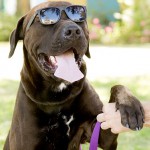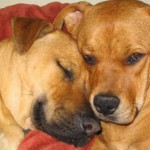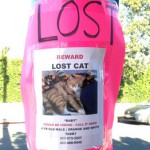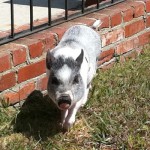October 6, 2010
When you watch if your dog is afraid of skateboarders, you need someone to pass by you and your dog on a skateboard, over and over again. If a dog needs to learn to coexist with other dogs, Cesar takes her to his camp where dozens of his canine assistants will help accomplish the task. My point is, you cannot do any of these alone.
In a city like Los Angeles, many people live alone. When I was walking a rescued dog, who needed to be exposed to other dogs in a proper way, knowing this dog was just shy but not aggressive, I asked a neighbor, who had a dog, Bobby, to please let the dogs meet and greet.
She harshly shut me down, “Practice with other dogs!”
At this very moment I was reminded that this is one of the very causes of today’s dogs’ misbehaviors. The woman and Bobby eventually moved away, and I do not know how Bobby is doing now, but since she was yanking him away from almost every dog, I saw Bobby progressively becoming aggressive to other dogs. The very last time I saw Bobby was when he was barking his head off at my dogs who were glancing at him from the other side of the street.
Making a community a pleasant place to live takes a community effort. And that includes how you handle your and others’ dogs.
I’ve learned over the years that there are “dog lovers” and “pet lovers.” The former care about dogs in general. These are the people who would stop their car and rescue a stray dog from the street. The latter is those who only care about their own pets. These are the people who look the other way when a lost dog needs their help, even when they look into the dog’s pleading eyes.
When I see someone being uncomfortable on the street, watching me and my dogs approaching her and her dog, I slow down and ask how her dog does with other dogs. If her dog is just shy, I offer one of my dogs, who is like a social worker, to say hello to her dog in a proper way, so that she eventually won’t have to avoid every dog they encounter on their walks. When the person is open to give it a shot, it works well every time. But if the other dog’s handler is unsure or afraid, I won’t push it because I know it won’t work.
If more people are willing to help others with their dogs, they (both human and dogs) will eventually get over the shyness and our community will have more friendly dogs . . .and people, consequently. I’ve witnessed many human fights in the dog park. A typical example is: An adult Shepherd growled and nipped (not a bite) at a young Lab who then yelped. In most cases, nobody gets hurt, but their humans may result in a fistfight, and one of them may get hurt, not the dogs.
For instance, in this case, the Shepherd was putting the youngster in his place. As in a wolf pack, young pups learn manners from their seniors. When dogs make noises, it sounds worse to us than what they actually mean. Especially when people see their teeth, they freak out. However, some adult dogs show their teeth to the youngsters as a warning with no intention of using them. I’ve seen many adolescent dogs immediately back off but not in fear. It’s just a learning process to them, but their humans interfere, shouting, “Get your aggressive dog away!” This creates the hostile atmosphere in which dogs react accordingly.
If these people understood what dogs are made of and let them be dogs, they would learn that dogs speak different language and realize that they actually know how to work things out among themselves. Dogs are pack animals, and they naturally seek to establish a hierarchical position in the pack. What is important is the guardian of the alpha dog (an alpha dog means a dominant dog) has to be the ultimate boss to keep the pack under control. When the guardians shout and freak out, that represents weakness and instability and creates the wrong type of excitement, which is the energy dogs react to and a fight breaks out.
In this city, many people are either sue-crazy or afraid of being sued. They should add “liability” or “lawsuit” in the dictionary under the definition of “dog” because those are the first words we hear whenever a dog misbehaves. Not “training” or reflecting on what they (the human) may have done wrongly to have caused the dog’s misbehavior.
Dogs need to be dogs. Like we shouldn’t be deprived of communicating with other human beings, dogs need to speak dog, not just English. In today’s society, people are anthropomorphizing their dogs too much and forget to respect them as their own species. Just remember, when dogs meet, they don’t shake hands.
When two dogs ignore each other after their first hello, people often feel that the dogs don’t like each other. Quite the contrary! They are comfortable with each other, so that they don’t feel the need of incessantly checking each other out or being on guard.
In fact, one of my own dogs does not like Golden Retrievers. Who would not love sweet Golden Retrievers!? It used to upset me when my dog snubbed a wiggly Golden Retriever approaching him to say, “Hi.” I eventually understood that while Golden Retriever is one of the most suitable breeds for the urban lifestyle, it is not necessarily so in the dog world because their over-friendly behavior is not proper manners until the dogs officially meet in their way, speaking “dog” (not English). This is because dogs like Goldens are more “un-dogged.” Many of them do not follow through the ritual of checking each other’s status; i.e., sniffing accompanied with body language, which would acknowledge their hierarchical positions, defining who is alpha and so forth.
This Golden was in my dog’s face, as if saying, “I’m your friend! Yay, yay, yay!” How annoying would that be if someone you’ve never met before runs up to you, gives you a wet kiss and puts a huge grin an inch away from your nose? So, my dog gruffly responds, “Back off! Who do you think you arrrre!?” And it’s he who now looks rude to human eyes. See how backwards we interpret the dogs’ language?
When I rescued my second dog, I went out of my way and “un-dogged” her, to make her better fit today’s society. She was rescued from the streets in South Central, where she learned survival skills. She was still six or 7 months old when rescued, but was already street smart. She’s a medium size dog, but low to the ground with stubby legs, so she’d naturally be the bottom of the hierarchy. She had to survive by charming even the most aggressive dogs. She knew how to stay still, let the macho dogs check her out, without showing any sign of fear. Her calm, non-confrontational energy always simmers down the dogs who are on the fence. With one wrong move on her part, even just a tiniest of an eye movement, the macho dog would put her down on the ground.
One day at a dog park, she was attacked by another dog. This time, she didn’t feel it was justifiable. I saw a flash of a thought, which was about to go through her mind, to retaliate. Before she even finished her thought, I disciplined her. People couldn’t understand what I was doing and said, “Why are you scolding your dog? She was the one who was attacked!”
I did not want my dog to learn to retaliate. I wanted her to stay at the bottom of the hierarchy, so that she would never cause trouble in an urban society. What she was trying to do was correct in the dog world, otherwise, she wouldn’t survive. I felt a combination of sadness and pride in her, when she looked at me as she followed my order so beautifully. It felt even more bittersweet because she was not questioning me. How obedient!
As I love the beauty of their natural being, forming a pack and all, I sometimes wish I lived in farmlands, living with a bunch of dogs in an isolated ranch where nobody would sue me if my Border Collie mix chased a visitor and nipped at his heel.
Dogs are dogs. Excitable dog owners should chill and learn the difference between a fight and rough play, the difference between a bite and nip, and the difference between aggression and assertiveness (and become their “guardian”). Above all, love your dog as a dog. Then your compassion may extend to other dogs, too, and you’ll become a real “dog lover.”
Marie Atake is Founder & President of Forte Animal Rescue and a former Commissioner on the Board of L.A. Animal Services.






